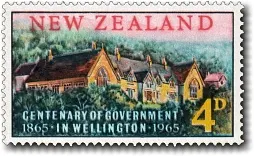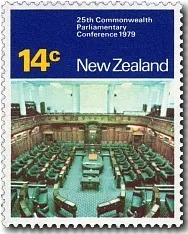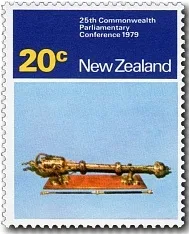This post can be looked at, as a thematic collection of Parliament Building stamps, or as a history of Parliament in New Zealand. Below is the miniature sheet of the 2004 - 150 Years of Parliament issue. Rather than grouping the stamps by their issue date, I'm going to arrange them according to the time period of the buildings they show. The 2004 issue will be our guide through this interesting subject, with the five stamps acting as headings to the various sections/time periods.
Almost immediately on taking ownership, the new Government began a series of extensions to the General Assembly Building - including, in 1899, the General Assembly Library. Made of brick, cement and plaster in Gothic Revival style, it was the only building to survive a disastrous fire in 1907 that destroyed the adjacent (wooden) General Assembly Building. Damaged by another fire in 1992, the renamed 'Parliamentary Library' has since been completely refurbished and strengthened against earthquakes.
1996 - First Mixed Member Proportional Election (MMP)
A cartoonish view of the Beehive as a ballot box for the first MMP Elections.
While not a serious view of the building it is of some interest here.
1996 MMP Elections.
2015 - Singapore World Stamp Exhibition.
1854 Parliament Building, Auckland.
New Zealand's first Parliament was housed in a specially constructed building in central Auckland near to Government House, the official residence of the Governor of the Colony. There, on 24 May 1854, the 37 Members of Parliament began their work after a first-past-the-post election that involved 24 single and multi-member electorates. The site is now a historical reserve - none of the original buildings remains.
40c & 45c - 1854 Parliament Building, Auckland.
In 1854 New Zealand's the first official Parliament assembled in what was then the capital city of Auckland. Its representatives were tasked with an important and influential role: making the laws that would govern this relatively young country, and keeping the work of government under scrutiny and review. The 1854 Parliament commenced with 37 members (today there are around 120 members). Since then, 46 Parliaments have been elected, making New Zealand one of the oldest continuously functioning legislatures in the world.
The 40c stamp was replaced with the 45c stamp due to a rise in postage.
1865 Parliament Buildings, Wellington.
90c - 1865 Parliament Buildings, Wellington (Provincial Chambers).
4d - Wellington Provincial Council Building / Parliament.
In 1865 the New Zealand Parliament moved cities - to the Provincial Council Chambers in Wellington. Built in 1857, the building was designed with the needs of Parliament in mind, a key strategy in Wellington's campaign to become the country's new capital city. The building was sold to the new colonial Government and renamed the General Assembly Building.
This Special Cover shows various views of Parliament Buildings in Wellington.
The small photos appear to be from top:- The 1899 Parliament Buildings; The Great Fire of 1907; The 1918 Parliament House; 1972-73 Beehive Under Construction. Notice the 2015 Singapore World Exhibition stamp with its Beehive cancel.
1899 Parliament Buildings, Wellington.
$1.30 - 1899 Parliament Buildings, Wellington.
Almost immediately on taking ownership, the new Government began a series of extensions to the General Assembly Building - including, in 1899, the General Assembly Library. Made of brick, cement and plaster in Gothic Revival style, it was the only building to survive a disastrous fire in 1907 that destroyed the adjacent (wooden) General Assembly Building. Damaged by another fire in 1992, the renamed 'Parliamentary Library' has since been completely refurbished and strengthened against earthquakes.
1918 Current Parliament House.
$1.50 - 1918 Parliament House, Wellington.
1d - Parliament House Wellington.
The 1d stamp shows Parliament House in Wellington with a portrait of King George VI
inset in an oval frame to the left.
In 1912 work commenced on a replacement Parliament House on land adjacent to the former General Assembly building. The new building was occupied in 1918 and has been the home of the New Zealand Parliament ever since. However, in 1992 the building was temporarily vacated so that it could be refurbished and strengthened against earthquakes. It was reoccupied in 1996. Originally designed in a competition by architects John Campbell and Claude Paton, this Edwardian neo-classical building has a base of Coromandel granite and upper storeys of Takaka marble. The interior features New Zealand native timbers.
2001 Queen Elizabeth II Royal Visits.
40c - Royal Visit 1953.
The young Queen arriving for the State Opening of Parliament.
(2001 Queen Elizabeth II Royal Visits.)
1965 11th Commonwealth Parliamentary Conference in Wellington.
4d - New Zealand Arms & Queen Elizabeth II.
2/- The City of Wellington in 1965.
9d - Parliament Buildings in 1965.
The Commonwealth Parliamentary Association was established to promote the ideals of parliamentary democracy and the rule of law. The Association had held conferences annually since 1961. In 1965 the conference was held in Wellington and to mark the occasion a set of three commemorative stamps was issued. On each stamp, the emblem of the Association, a Mace and Black Rod crossed, was incorporated into the design.
1977 The Beehive.
$2.00 - 1977 The Beehive, Wellington.
The 14-storey Beehive is more than the Executive Wing of Parliament; it is a focal point of the Wellington landscape. Unique in New Zealand, it was designed by Sir Basil Spence, an internationally significant architect known for his controversial works. This circular, reinforced concrete structure was built according to a 'modern classical brutalist' style. Originally conceived in 1965, construction began in 1970 and finished in 1981.
1974 New Zealand Day.
4c - Parliament Buildings and the Beehive.
The stamp was one of five included in a miniature sheet to mark New Zealand Day. The picture looks much as an architectural drawing would look because when this stamp was issued the Beehive was still under construction.
1979 25th Commonwealth Parliamentary Conference in Wellington.
14c - Debating Chamber of the New Zealand House of Representatives.
20c - Mace and Black Rod / Parliamentary Symbols.
30c - Mural in the 'Beehive' Foyer, Parliament.
When the 25th Commonwealth Parliamentary Conference opened in Wellington in November 1979, the New Zealand Post Office released a set of three stamps to commemorate the event. It was the third time New Zealand had played host to this conference, the previous occasions were in 1950 and 1965, and the second time New Zealand stamps had commemorated such an event.
1981 Definitive Issue.
$5 - Beehive, Parliament Buildings, Wellington.
(1981 - Definitive Issue.)
Only part of the original complex for New Zealand's Parliament Buildings was constructed, and these were occupied in 1918. The complete design included a south wing, a dome over the main entrance hall and statuary. In the early 1960s, it was decided to provide a modern building as an extension of the old buildings, as the accommodation in Parliament Buildings had been inadequate for a number of years.
The Beehive, designed by the New Zealand Government Architect from a concept proposed by a prominent British architect, the late Sir Basil Spence, is a circular 11-storey building made of concrete faced with granite and marble and has a copper roof. As well as Ministerial offices, the Beehive contains a banqueting hall, Bellamy's restaurant, a cinema, the Prime Minister's suite and the Cabinet room.
1996 - First Mixed Member Proportional Election (MMP)
A cartoonish view of the Beehive as a ballot box for the first MMP Elections.
While not a serious view of the building it is of some interest here.
1996 MMP Elections.
2015 - Singapore World Stamp Exhibition.
$2.50 - Parliament Buildings, Wellington.
This joint issue features a new $2.50 New Zealand stamp that shows New Zealand’s most iconic parliament building - the Beehive. The Beehive is where many ministers have their offices, including the Prime Minister of New Zealand. Designed by the British architect, Sir Basil Spence, the idea behind the building is that the rooms and offices should radiate from a central core. The building was opened in 1977, with full occupancy occurring around 1979 once the upper floors were opened.
1877 Government Buildings.
While it could be debated that this is not actually a Parliament Building, we have decided to include it here as part of this collection.
30c - Government Buildings, Wellington. $1.30 - Government Buildings, Wellington.
30c - Government Buildings, Wellington. This massive 1877 wooden building was designed by W A Clayton New Zealand's first Colonial Architect who, it is claimed, was 'the first to use wood successfully in a grand manner'. The way in which wood has been used in the detail of the exterior to simulate traditional stone architecture is worth noting. The building is often spoken of as the largest wooden structure in the Southern Hemisphere. An extensive restoration project of this building was completed in 1995.
$1.30 - Government Buildings, Wellington.
The Government Buildings, famously the biggest wooden structure in the Southern Hemisphere (and the world's largest timber office building), has been a symbol of Wellington's focus as a public service city for 125 years.
Some of the text in this post came from the NZ Post Web Site.
Some of the images in this post were used with permission from the illustrated catalogue of StampsNZ
You can visit their web site and On-line Catalogue at, http://stampsnz.com/























Now this is what I like. A collection of stamps arranged to tell a story.
ReplyDeleteI learnt a lot about our Parliament Buildings reading this.
Well done Asami.
Paul
Thank you Paul.
ReplyDeleteI enjoyed doing and learnt much too. I did not know that Auckland was once the capital city.
Allan snr said, "Yes we sent all the politicians away to Windy Wellington so us in Auckland can get on with our business in peace."
LOL That was funny!
I am more interested in the histories and stories of New Zealand than the stamps.
That is why I like these kind of blog posts.
Asami
I understand you have only been in New Zealand a few years Asami.
ReplyDeleteHow come you girls know so much about your new country?
Marceau
My thematic is a parliament buildings of various countries on the stamps. My collection in this thematic small doubts in new Zealand parliament . But now I am cleared in your notes
ReplyDeleteI was asked to create this thematic collection of New Zealand Parliament stamps as the other writers were busy. I am not a stamp collector and normally do IT and coding things in these blogs.
DeleteAs far as we know these are all the stamps from New Zealand with this theme. I hope you found my page as a useful guide to this part of your collection.
Asami
We appreciate your engagement with our content. To ensure a respectful and constructive community, please take note of the following:
- No Spam, Please: We do not tolerate spammy or promotional comments. Any such comments will be promptly removed.
- Moderation in Place: All comments are moderated to maintain a positive and inclusive environment. Please be patient, as it may take a little time for your comment to appear.
- Sign In with Google: To comment, please sign in using your Google account. This helps us maintain the integrity of our community and allows for better interaction.